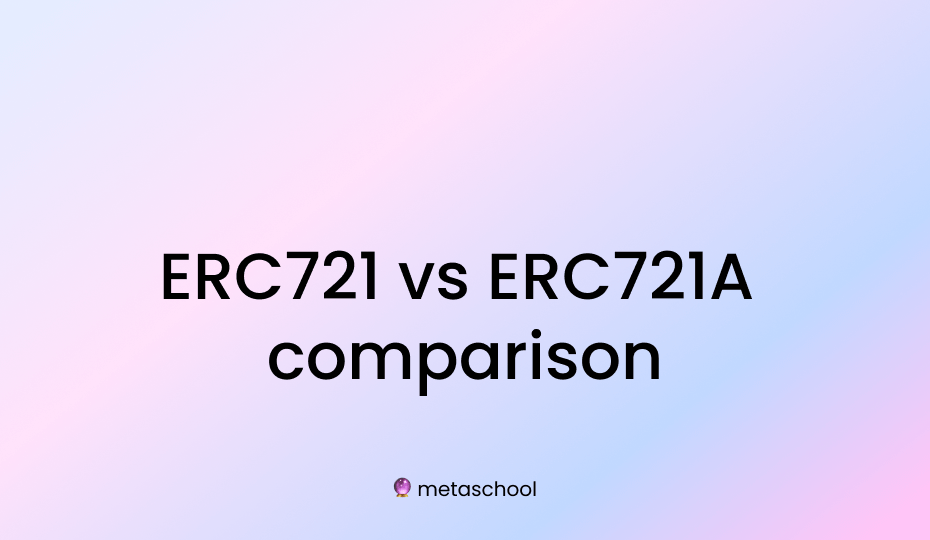Table of Contents
ERC721 vs ERC721A may look like they’re accomplishing the same goal but there are some important distinctions. Let’s see what they are.
As the world of digital assets continues to evolve, non-fungible tokens (NFTs) have emerged as a popular way to represent unique, digital items. From collectible items to digital art, NFTs allow creators to mint unique digital assets that can be bought and sold on the blockchain.
That being said, two of the most commonly used Ethereum NFT standards are ERC721 vs ERC721A, and understanding the differences between these standards is crucial for anyone working with NFTs.

One key difference between the two standards is the ability to perform batch minting of NFTs.
So, in this blog we’ll explain what batch minting is and how it’s supported by each standard. We’ll also discuss the pros and cons of each standard and provide some guidance on which one might be the best choice for your NFT project.
Whether you’re a creator looking to mint your own NFTs, or an investor interested in buying and selling unique digital assets, you stand to gain some pretty valuable information on the differences between ERC721 vs ERC721A. Ready? Let’s goooo.
What is batch minting?
Batch minting refers to the ability to create multiple non-fungible tokens (NFTs) at once, rather than creating them one by one. This can be useful for creators who want to quickly and efficiently mint a large number of NFTs, such as for a collection of digital art or a series of collectible items.
With batch minting, multiple NFTs can be created using a single transaction, which can save time and reduce the amount of gas (Ethereum’s transaction fees) required.
Batch minting is supported by the ERC721A standard, but not by the original ERC721 standard. This means that if you want to mint multiple NFTs using ERC721, you must do so using multiple transactions. This can be time-consuming and cumbersome. ERC721A, on the other hand, allows for efficient batch minting of NFTs.
Let’s take a deeper look at the both. 👇🏼
⚡️ The ERC721 token standard
ERC721 is the original Ethereum standard for non-fungible tokens (NFTs). It defines a set of rules and standards that must be followed in order to create and manage NFTs on the Ethereum blockchain.
Features of ERC721
Some key features of the ERC721 standard include:
- The ability to mint unique digital assets that cannot be replicated or replaced
- A method for transferring ownership of NFTs from one person to another
- A mechanism for querying the details of an NFT, such as its name, symbol, and owner
Limitations of ERC721
One major limitation of the ERC721 standard is that it does not support batch minting. This means that NFTs must be created individually using the mint() function, which can be time-consuming and inconvenient.
Additionally, ERC721 contracts can only track the ownership of a single NFT at a time, so multiple mint() transactions must be performed in order to mint multiple NFTs. This can be inefficient and can also increase the amount of gas (Ethereum’s transaction fees) required.
When to use ERC721
Despite its limitations, ERC721 is still a useful standard for certain types of NFT projects. If you don’t need to mint a large number of NFTs, or if you don’t mind creating them individually, then ERC721 may be the right choice.
Additionally, if you’re working on a simple NFT project that doesn’t require the advanced features provided by ERC721A, then ERC721 can be a good option. It provides a basic set of features for creating and managing NFTs, and it is widely supported by a variety of wallets and other tools.

⚡️ The ERC721A token standard
ERC721A is an updated version of the ERC721 standard that includes additional features and functionality. It builds upon the original ERC721 standard and adds support for batch minting, as well as the ability to track the ownership of multiple NFTs simultaneously.
Features of ERC721A
Some key features of the ERC721A standard include:
- The ability to mint multiple NFTs at once using the
batchMint()function - A method for transferring ownership of multiple NFTs at once
- A mechanism for querying the details of multiple NFTs at once, such as their names, symbols, and owners
Advantages of ERC721A
One of the major advantages of ERC721A is its support for batch minting. This allows creators to efficiently mint large numbers of NFTs, and it also enables the contract to track the ownership of multiple NFTs simultaneously.
Additionally, the ability to track the ownership of multiple NFTs can be useful for certain types of NFT projects, such as collections of digital art or series of collectible items. This can make it easier to manage and track the ownership of a large number of NFTs.
When to use ERC721A
ERC721A is the superior choice for NFT projects that require batch minting or the ability to track the ownership of multiple NFTs. If you plan to mint a large number of NFTs and want to do so efficiently, then ERC721A is the better option.
Additionally, if you’re working on a more complex NFT project that requires advanced features such as batch minting or the ability to track multiple NFTs, then ERC721A may be the right choice. It provides a more robust set of features for creating and managing NFTs, and it is supported by a growing number of wallets and other tools.
Ultimately, which standard should you use? 🤔
As a developer, whether you should use ERC721 vs ERC721A for your NFT project depends on your specific needs and requirements.
If you don’t need to mint a large number of NFTs, or if you don’t mind creating them individually, then ERC721 may be a good choice. It provides a basic set of features for creating and managing NFTs, and it is widely supported by a variety of wallets and other tools.
However, if you plan to mint a large number of NFTs and want to do so efficiently, or if you need the ability to track the ownership of multiple NFTs, then ERC721A is the better option. It allows for more efficient and convenient minting, and it also provides additional functionality for managing multiple NFTs.
Ultimately, the right choice will depend on the specific requirements of your NFT project. It may be worth considering both standards and evaluating their relative strengths and limitations before making a decision.
In summary, ERC721A is the superior choice for NFT projects that require batch minting, while ERC721 is a good option for simpler projects that don’t require this functionality.

